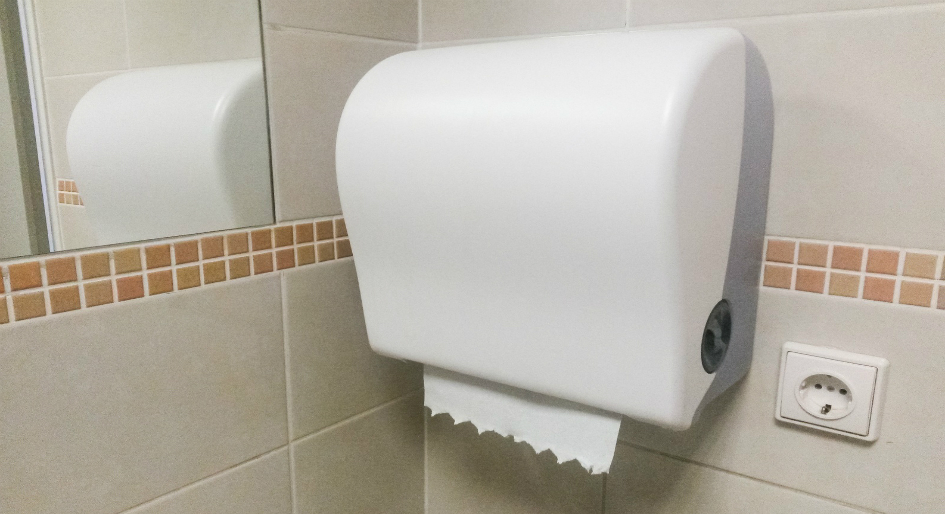Some businesses across North America are now allowed to reopen, presenting them with an opportunity to earn much-needed revenue from in-person sales. However, facilities should take care when reopening to ensure employees and guests feel safe, including addressing hand hygiene best practices. As opinions differ on the optimal way to hygienically dry hands, it’s important to review evidence regarding paper towel and air dryer usage. By stocking the right washroom essentials to encourage proper hand drying and reduce the spread of germs, facilities can create conditions conducive to safe reopening and operation.
Paper towels versus air dryers
Drying hands well accomplishes two critical hand hygiene tasks: aiding in the removal of pathogens from hands, and making hands less likely to attract and spread germs. But not every method of hand drying works with the same level of effectiveness. Thus, it is important for businesses to understand why hand drying is crucial to overall hand hygiene, in addition to supplying customers and employees with the means to dry their hands consistently and thoroughly after washing them.
Researchers have gathered a variety of evidence supporting paper towels as an ideal solution for drying hands, as well as the preferred method of most Americans, including:
- Air dryers can spread germs through the air onto clothing and hands. A study in the Journal of Applied Microbiology compared the dispersal of a virus that resulted from using three hand-drying methods – standard warm air dryers, jet air dryers, and paper towels. The jet air dryer dispersed the virus quite forcefully – 190 times more than paper towels and 20 times more than warm air dryers, at six different heights and nine different distances.
- Using paper towels can reduce virus transmission, while using air dryers can increase it. A recent study from University of Leeds, conducted in a hospital environment, found that those who use air dryers have a greater potential to contaminate surfaces by touching them than paper towel users do. Mark Wilcox, an author of the study, explained to Healthline that because some people do not follow the correct hand washing procedures, remaining microbes on their hands can be further dispersed throughout the washroom by a powerful jet air dryer. The authors conclude, “As public toilets are used by patients, visitors, and staff, the hand drying method chosen has the potential to increase or reduce pathogen transmission.” In other words, jet air dryers can potentially spread pathogens while paper towels help remove them.
- People prefer paper towels. A survey completed before the novel coronavirus pandemic showed more than two thirds (69 per cent) of Americans prefer to use paper towels over air dryers in public bathrooms. Of those that prefer paper towels, the top reasons for their preference were that paper towels dry hands faster and better, and that they can use paper towels to open washroom doors without touching them. The pandemic has increased hypersensitivity around cleanliness and hand hygiene, and it’s likely that many people will still want to avoid touching doors, faucets, and other fixtures in washrooms as much as possible.
Best practices for washrooms
As coronavirus is still circulating and no vaccine is currently available, businesses should consider the following:
- Address customer preferences. Find the right paper towels so customers and employees can dry hands effectively. This may mean seeking out a more absorbent option, to maximize efficiency. If your facility already has air dryers in place, consider also installing paper towel dispensers to give visitors different options. This way, if they don’t want to use an air dryer, they aren’t discouraged from drying their hands.
- Reduce touchpoints. Automated soap and paper towel dispensers can help prevent the spread of germs, as can automated faucets. Some facilities may also want to install automated doors, which help eliminate the need to touch a doorknob or handle. If automated doors are not feasible, providing door tissue with a convenient waste bin next to the door can help occupants avoid touching a handle.
- Highlight hand washing and drying methods. While many of us are accustomed to seeing signs instructing employees to wash hands after using the washroom, it’s also important to encourage your customers, residents, or visitors to do the same. In addition to instructing people on hand washing best practices, stress the importance of thorough hand drying using illustrative posters and succinct copy.
Together, these measures can help create more hygienic washrooms and a safer facility overall.
Overlooked, underrated
Hand hygiene often brings to mind images of soapy hands and running faucets, maybe even the occasional bottle of hand sanitizer. Washing hands for 20 seconds or more with soap and water, or using alcohol-based hand sanitizers when no sink is available, are incredibly important components of hand washing. However, in light of the COVID-19 pandemic, businesses should also focus on the role that proper hand drying plays in keeping customers and employees safe.
As research demonstrates, paper towels are a very hygienic way to dry hands. They not only provide the friction needed to remove pathogens from hands, but they also pose less of a risk of spreading disease-causing pathogens throughout the air. At a time when people are paying more attention to how businesses are safeguarding employees and patrons, it’s crucial for facilities to consider paper towels as an effective hand drying option and a way to promote the wellbeing of customers and staff alike.
Giorgia Giove is marketing manager for the Away from Home business at Sofidel, a world leader in the manufacture of paper for hygienic and domestic use, including its Papernet brand. For more information, visit www.papernet.com/americas.








